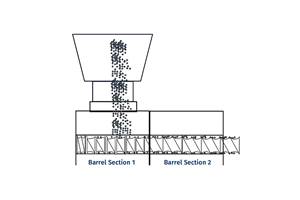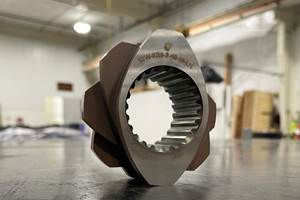In Twin-Screw Compounding, Distinguish Between ‘Disease’ and ‘Illness’
The concept of troubleshooting in compounding can be defined in terms of a problem (or problems) with compound quality or as a problem with the compounding process.
The concept of troubleshooting in compounding can be defined in terms of a problem (or problems) with compound quality or as a problem with the compounding process. The latter may or may not be seen by the customer, as these troubles result in lost productivity for the compounder: strand drops, vent port fouling, etc. In either case, the strategy to identify an assignable cause (and cure) is to first determine if the problem is chronic or transient.
DISEASE OR ILLNESS?
A parallel can be drawn between diagnosis of twin-screw compounding extruders and diagnosis of the human anatomy. Chronic compounding problems are like diseases—they are always present and the cure requires extensive treatment, while transient problems can be thought of as “illnesses.” An illness is temporary and the treatment is relatively simple.
We identify problems in compounding as chronic if the results are the same every time a particular blend is run—every lot produces the same poor physical properties, black specks, dropped strands, frozen die holes, fouled vent ports, etc. In these cases, the problem cannot be the result of a particular lot of raw materials, worn extruder components, or any other temporary condition. The symptoms of chronic problems suggest that the process itself is the problem: improper screw or die design and/or operating conditions. For these problems, the treatment requires redesigning the screw configuration or modifying the compounding process.
On the other hand, if a particular compound has been produced successfully in the past, and today it runs differently, this is the symptom of an illness. Now we must determine why the current condition exists and whether it is causing compound quality problems or processing problems. The assumption here is that the problem is not related to a specific lot of raw materials.
What variables can change from lot to lot of compound and how do they manifest themselves? The potential sources of variation between compound lots are described below, listed in the order in which they impact the compounding process and compound quality:
SCREW DESIGN
It is possible that the installed screw design is incorrect if the plant routinely disassembles and changes configurations. If the screws are assembled in a different sequence than is specified, the resulting process can run differently and produce a different material. If the screw configuration is never changed, this variable becomes a constant.
Screw and barrel wear can result in both processing problems and compound quality problems between lots that are produced more than several weeks or months apart (if the same compound is run over an extended period of time, compound quality will be deteriorating slowly and sequential lots will not differ greatly from each other).
The effect of wear on extruder components is most often observed when sufficient time has passed between lots. The worn condition of the extruder results in a different processing behavior or pellet quality, depending on where the wear is occurring.
Wear of screws and barrels can occur in conveying sections after the main feed port and after downstream feeding of abrasive fillers. The resulting enlarged clearance reduces the conveying capacity and can result in feed backing up into the feed port(s). The compounder is forced to reduce capacity, losing productivity. Wear in this area has little or no effect on compound quality.
Wear of conveying screws and barrels where the extruder is building die pressure can result in melt backing up into vacuum vent ports from reduced conveying efficiency. While this may seem to be an operational (process) problem, the reduced vacuum efficiency can result in poor pellet quality (increased porosity or voids) and strand drops. Enlarged clearances in the pressurization section of the extruder can also produce black specks.
Wear of kneading elements in the melting section results in reduced melting efficiency. If this process requires downstream feeding of filler, the unmelted resin creates a mixing problem downstream and manifests itself as inadequate dispersion and poor physical properties.
Wear of kneading elements in downstream mixing sections translates to poor physical properties. If the wear is excessive, unmixed filler also shows up as increased strand drops and can require an increased frequency of screen changes (i.e., loss of productivity).
SCREW SPEED
It is not likely that the screw speed will vary from lot to lot without intentionally making this adjustment.
FEED RATE
Feeders may be blamed for many compounding problems, but not normally for lot-to-lot variation. The inherent short-term variability of gravimetric feeding equipment will not change over time (unlike the extruder, which wears over time). While it may be possible for the incorrect screw to be installed in the compounding extruder, an incorrect screw in the feeder may force the gravimetric system to run at a higher (or lower) speed to maintain mass-flow setpoint. As long as the feed rate is the same, it has no impact on the process or product. However, if one or more gravimetric feeders is operating incorrectly on any particular lot (usually as a result of improper setup), the resulting alteration in formulation will result in a different product (typically identified with ash testing) and can also produce a different torque, pressure, or melt temperature, depending on the material and how much variance is introduced by the change in feeder performance.
EXTRUDER/DIE TEMPERATURE
Temperature control of the compounding extruder barrels and die is a likely source of variation between lots, however, the contribution of thermal energy to the overall compound properties is relatively small. Extruder heating/cooling systems are prone to many mechanical failures (burned-out heaters, sticking solenoid cooling valves) as well as changes in performance over time (mostly due to modifications made to PID tuning, alteration of cooling-valve settings after controllers have been tuned, etc.). These variations rarely result in changes to physical properties, though they can wreak havoc on processing (e.g., poor die flow from improper die heating results in problems at the pelletizer).
ENVIRONMENT
If the time between lots is long enough, changes in the environment can result in differences between lots as well as differences in operation. For hygroscopic materials, variation in atmospheric humidity and/or outside air temperature can be observed in processing. Running the same compound in the summer and winter can have a significant effect on the compounding process—for example, when raw materials are coming from a silo or railcar if the plant is located in a cold climate.
The “trouble” with troubleshooting is the lack of understanding by operating personnel as to how the machine configuration and process parameters interact with raw materials to produce compound physical properties. Formal training in twin-screw extrusion technology can provide front-line personnel with the tools to diagnose problems quickly and thereby increase productivity. Along with staff training, a good preventive maintenance program is also required to eliminate some of the “usual suspects” from causing problems.
About the Author
Adam Dreiblatt has been involved in twin-screw extrusion technology for 30 years and is currently the director of process technology for CPM Century Extrusion, Traverse City, Mich. He can be reached at (231) 947-6400 or by email: dreiblatta@centuryextrusion.com
Related Content
Improving Twin-Screw Compounding of Reinforced Polyolefins
Compounders face a number of processing challenges when incorporating a high loading of low-bulk-density mineral filler into polyolefins. Here are some possible solutions.
Read MoreHow to Configure Your Twin-Screw Extruder -- Part 2
Follow these tips to configure your twin-screw elements to promote feeding and solids conveying.
Read MoreMore Than a Compounder: They Have the Science to Create New Custom Materials
Insight Polymers & Compounders leverages its expertise in polymer chemistry to develop next-generation materials.
Read MoreHow to Configure Your Twin-Screw Extruder: Part 3
The melting mechanism in a twin-screw extruder is quite different from that of a single screw. Design of the melting section affects how the material is melted, as well as melt temperature and quality.
Read MoreRead Next
Understanding Melting in Single-Screw Extruders
You can better visualize the melting process by “flipping” the observation point so that the barrel appears to be turning clockwise around a stationary screw.
Read MoreHow Polymer Melts in Single-Screw Extruders
Understanding how polymer melts in a single-screw extruder could help you optimize your screw design to eliminate defect-causing solid polymer fragments.
Read More












.png;maxWidth=300;quality=90)













